Intel NUC 13 Pro Arena Canyon Review: Raptor Lake Brings Incremental Gains
by Ganesh T S on March 27, 2023 9:00 AM ESTSystem Performance: UL and BAPCo Benchmarks
Our 2022 Q4 update to the test suite for Windows 11-based systems carries over some of the standard benchmarks we have been using over the last several years, including UL's PCMark. New additions include BAPCo's CrossMark multi-platform benchmarking tool, as well as UL's Procyon benchmark suite. BPACo recently updated their SYSmark benchmark suite - while operational at a basic level, it is missing key features such as energy consumption measurement. We will start including SYSmark 30 once the open issues are resolved.
UL PCMark 10
UL's PCMark 10 evaluates computing systems for various usage scenarios (generic / essential tasks such as web browsing and starting up applications, productivity tasks such as editing spreadsheets and documents, gaming, and digital content creation). We benchmarked select PCs with the PCMark 10 Extended profile and recorded the scores for various scenarios. These scores are heavily influenced by the CPU and GPU in the system, though the RAM and storage device also play a part. The power plan was set to Balanced for all the PCs while processing the PCMark 10 benchmark. The scores for each contributing component / use-case environment are also graphed below.
| UL PCMark 10 - Performance Scores | |||

The productivity workload sees the Ryzen 7-5800U system come out on top (thanks probably to the presence of 8 high performance cores), but that system loses steam in other components. The overall scores are along expected lines - the Intel RPL-P system is ahead of the ASRock Industrial RPL-P one, which in turn is a bit in front of the Alder Lake-P systems.
UL Procyon v2.1.544
PCMark 10 utilizes open-source software such as Libre Office and GIMP to evaluate system performance. However, many of their professional benchmark customers have been requesting evaluation with commonly-used commercial software such as Microsoft Office and Adobe applications. In order to serve their needs, UL introduced the Procyon benchmark in late 2020. There are five benchmark categories currently - Office Productivity, AI Inference, Battery Life, Photo Editing, and Video Editing. AI Inference benchmarks are available only for Android devices, while the battery life benchmark is applicable to Windows devices such as notebooks and tablets. We presents results from our processing of the other three benchmarks.
| UL Procyon - Office Productivity Scores | |||

With similar processors and RAM, the NUCS BOX-1360P/D4 and the NUC13ANKi7 perform very similarly across all four components, getting on top in two each. The recorded scores are within the margin of run to run variations.
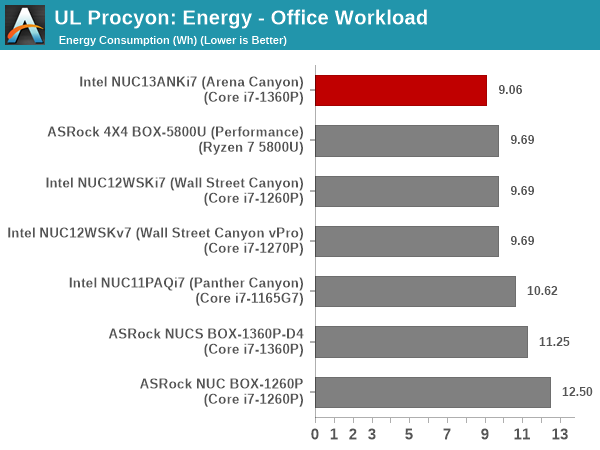
The Arena Canyon NUC forges ahead on the energy consumption front, though. In fact, the ASRock Industrial system comes way beind at 11.25 Wh compared to the Arena Canyon NUC's 9.06 Wh. These numbers can be due to different BIOS optimization targets.
Moving on to the evaluation of Adobe Photoshop and Adobe Lightroom, we find the Arena Canyon NUC come out comfortably on top, but it guzzles a lot more energy in the process compared to the 4x4 BOX-5800U.
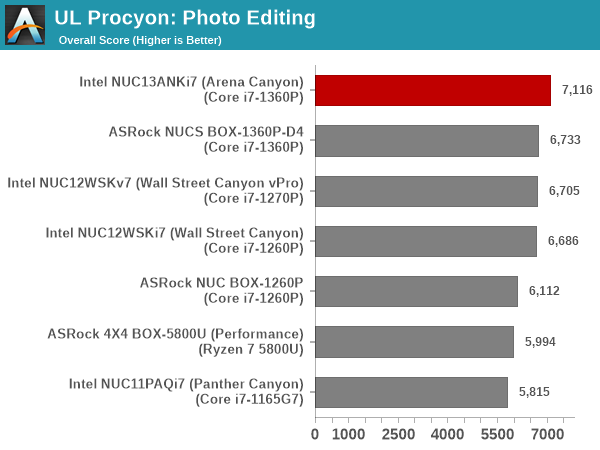
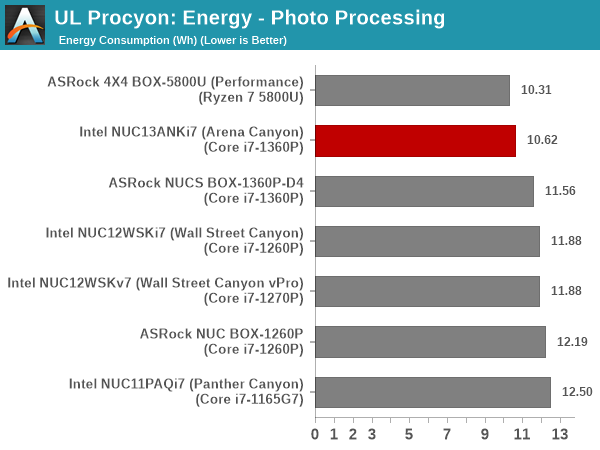
UL Procyon evaluates performance for video editing using Adobe Premier Pro, with the GPU playing a major role.
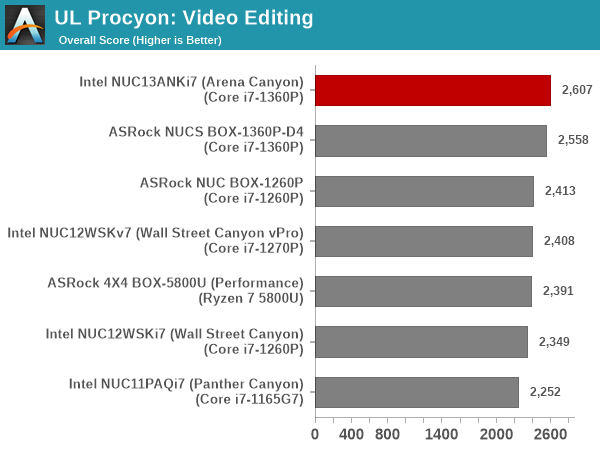
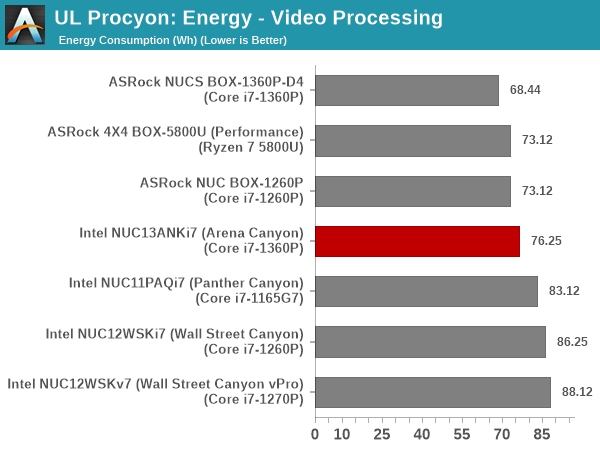
The aggressively clocked iGPU in the Core i7-1360P helps the Arena Canyon NUC and the NUCS BOX-1360P/D4 to deliver similar scores, with the former coming out on top. However, the energy consumption number is significantly higher despite the faster processing.
BAPCo CrossMark 1.0.1.86
BAPCo's CrossMark aims to simplify benchmark processing while still delivering scores that roughly tally with SYSmark. The main advantage is the cross-platform nature of the tool - allowing it to be run on smartphones and tablets as well.
| BAPCo CrossMark 1.0.1.86 - Sub-Category Scores | |||
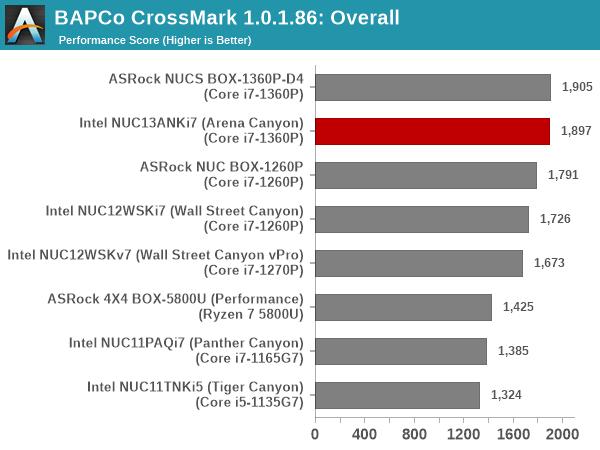
The relative performance seen in PCMark 10 translate to CrossMark also, as expected. The responsiveness ratings vary significantly due to differences in the default BIOS settings for options such as PCIe ASPM etc. We see the ASRock Industrial units emerge with high responsiveness ratings (ASPM disabled by default), while Arena Canyon opts to optimize for power efficiency by enabling ASPM. Overall, we see the Arena Canyon NUC score very similarly to the NUCS BOX-1360P/D4, and well ahead of the rest of the pack.










46 Comments
View All Comments
MrCommunistGen - Tuesday, March 28, 2023 - link
If you're just looking to dabble, you might check out Apple's Refurbished shop. I swear by their shop and use it to help my parents getting inexpensive iDevices as they don't need the latest and greatest.They tend to sell pretty lightly used machines that are only a generation or two old at decently discounted prices. If you buy a laptop or other mobile device, I believe that all 1st party Apple Refurbished devices get a brand new battery as part of the refurb process.
FWIW, it looks like through the refurb site you can get an M1 Mac Mini with 16GB RAM and 512GB SSD for $809. Yes, you lose out on the improvements that the M2 brings, but it saves you almost $200 too.
The M1 is going to be plenty potent compared to your... Core2 Duo(?) based Macbook?
Glaurung - Tuesday, March 28, 2023 - link
If you can't stomach apple's prices, check out refurbished/lightly used apple gear on backmarket or, for older machines you can upgrade yourself, Ebay. Apple's official refurb store is great but you will never get more than about 15% off there. I love my apple gear, but I only ever buy used/refurb, because I cannot afford the price Apple charges for new.Affectionate-Bed-980 - Tuesday, March 28, 2023 - link
For how "dead" Anandtech has been in terms of publishing GPU and CPU reviews, I'm surprised we get a NUC update and full review before this is even available for consumers!abufrejoval - Tuesday, March 28, 2023 - link
My NUC10 seems to just have burned through its Thunderbolt port: for some weeks it's lost the connection to the Sabrent/Aquantia 10Gbit NIC after a couple of days, but power cycling brought it back. Now it's just gone completely, just can't seen anything connected on TB any more.So while I needed a replacement, NUC12 is still rather expensive and I am still yearning for something Mini-ITX not NUC anyway, I hit across this one: https://elchapuzasinformatico.com/2023/03/cpu-inte... which is much cheaper than a comparable NUC of that generation.
So I just decided to order one to see if it holds water. I won't be able to reuse the RAM, but with 64GB at €120 that's no longer a pain point and it is a bit more flexible and expandable than the NUCs, while unfortunately it lacks the TB port, but will allow me to use one of my AQC107 PCIe x4 NIC in storage.
Mini-ITX with one of my Noctuas allows to raise the sustained TDP to 35 Watts without getting annoying, while idle power consumption might not be very different. That's my main beef with desktop based Mini-ITX hardware, I want the lowest idle power and then "comfortable" peak performance without getting distracted by noise, heat or electric bills.
H- and P-class SoCs from AMD and Intel basically allow that, but are hard-to-get in these smaller form factors: high-end notebooks obviously represent the more attractive sales channels and older parts are leak into these Chinese surplus channels only when laptops have switched to the next generation.
abufrejoval - Tuesday, March 28, 2023 - link
IMHO one of the biggest missing elements for several generations now has been lack of ECC support. With both "normal" and inline ECC most likely being included in the silicon, it's really just market segmentation again and a reason to go with Ryzen, if ECC support on their APUs wasn't such a lottery game, too.64GB is half a billion bits where things can go wrong and I just like the odds less and less...
Up2Trix - Wednesday, April 19, 2023 - link
@abufrejoval: I agree 100%. ECC DRAM is the single most important hardware feature that most people need but don't have a clue about. I curse Intel for segmenting it out of existence, and AMD for not promoting it. May the world wake up...Anyone know of a small form factor / NUC like computer with ECC support? Intel's NUC 9 Pro / Quartz Canyon from 2019 is the only one that I can readily find.
Fenturi - Tuesday, March 28, 2023 - link
I'm not sure the price/performance is here for this one vs chips like 6800HX with a much better igpu. That said two thunderbolt ports are very interesting for my use case and would be the best feature.abufrejoval - Tuesday, March 28, 2023 - link
I see the 96EU Xe doing 5-25% better than the 5800U iGPU and iGPUs typically get Wattage priority over CPUs so a "H" class iGPUs don't do better than "U", no matter if I operate the SoC at 15-28 (AMD) or 15-64 Watt (Tiger Lake NUC).So the 6800 generational uplift may just put AMD ever so slightly in the lead again, but in a race of sloths vs turtles.
For TB I keep hearing that many of the USB4 ports on AMD APUs are actually TB capable and only lack certifications... Have not had a chance to verify that.
I can't mix AMD and Intel in my clusters, so it's too late for me to switch. But the other thing is that I needed 10Gbit and for that TB sadly was a must, because for some crazy reason vendors believe 1/2.5Gbit is adequate for NVMe systems.
I've wanted mobile SoC based mainboards with PC type flexibilty for years, but only some crazy Chinese companies are selling that.
Fenturi - Tuesday, March 28, 2023 - link
Sadly, as someone who has built my own systems going back to 486 CPUs and outrageous fast wide SCSI and a super expensive video card.I think the days of building desktop PC is in it's last days.
Most people are going to only need small nuk sized units that will do most of what they need.
abufrejoval - Tuesday, March 28, 2023 - link
I can beat that, started with an 80286 (actually with an Apple ][ clone before that) and SCSI fast, wide or dual channel came much later, it was MFM and RLL before, using PIO, because the 8-bit DMA from the original PC simply wasn't fast enough for anything beyond floppy. BTW that system cost me more than a new middle class car would have and the people and shops selling them, would reflect that (suits, ties and talk): Those weren't just another microwave like box at the mall.Yes, after more than 4 decades the PC era is drawing to a close, but I'm not sure it's from lack of scale at the desktop: it's ARM from above and below that will spell the end of the x86 evolution.
There are way more PC enthusiasts today than there were PC users when we got hooked and custom builds just never scale: IKEA!
To me the real successor of the PC is the smartphone, but only if it isn't actually an Apple or Google remote control.